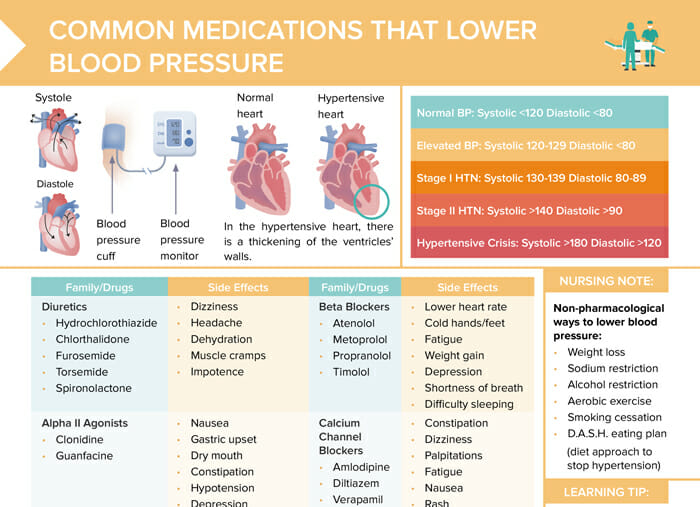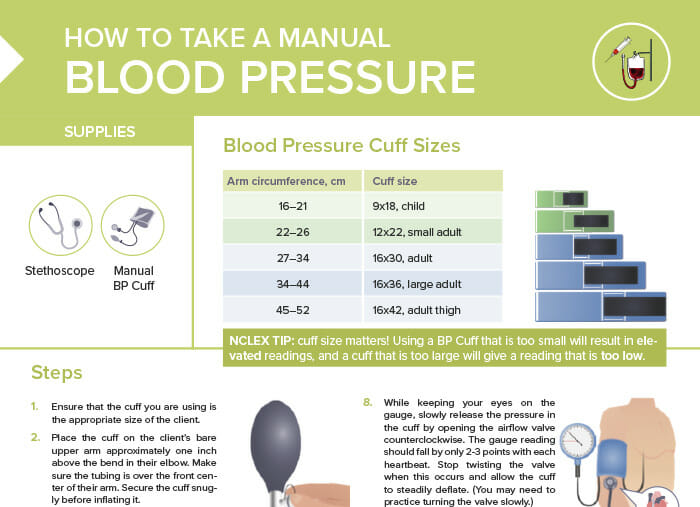What supplies are needed to take a manual blood pressure?
You only need a stethoscope and a manual blood pressure cuff, and a place for the client to sit and rest their arm.
How to choose the appropriate cuff size for a client
Choose the cuff size based on the client’s arm circumference.
| Arm circumference, cm | Cuff size |
| 16–21 | 9×18, child |
| 22–26 | 12×22, small adult |
| 27–34 | 16×30, adult |
| 34–44 | 16×36, large adult |
| 45–52 | 16×42, adult thigh |
How to take manual blood pressure: step-by-step guide
The steps for taking a manual blood pressure are as follows:
- Ensure the cuff you’re using is the appropriate size for your client.
- Place the cuff on the client’s bare upper arm, approximately one inch above the bend in their elbow. Make sure the tubing is over the front center of the arm. Secure the cuff snugly before inflating it.
- Make sure you can see the pressure gauge (it may be separate or attached to the wall).
- Close the airflow valve on the bulb by turning the screw clockwise with your thumb and forefinger.
- Palpate the brachial artery and place your stethoscope on the point where you palpated the pulse. Put the stethoscope earpieces in your ears. You should be able to hear the pulse.
- Inflate the cuff by squeezing the bulb multiple times with your right hand.
- Watch the gauge. Keep inflating the cuff until the gauge reads about 30 points (mm Hg) above your expected systolic pressure. At this point, you should not hear a pulse in the stethoscope.
- Keep your eyes on the gauge and slowly release the pressure in the cuff by opening the airflow valve counterclockwise. The gauge reading should fall by only 2–3 points with each heartbeat. Stop twisting the valve when this occurs and allow the cuff to steadily deflate.
- Listen carefully for the first pulse beat and note the reading on the gauge. This reading is your systolic pressure.
- Continue to slowly deflate the cuff until the heart sound disappears again, and note the reading on the gauge. This reading is your diastolic pressure.
- Quickly deflate the remaining air from the cuff by fully releasing the twist valve and remove it from the client’s arm.
How to palpate the brachial artery
Locate the brachial artery in the inner aspect of the bicep, slightly above the elbow crease. Palpating the brachial artery is easier to feel if the arm is slightly bent at the elbow. Use your index and middle fingers to apply moderate pressure at the location; you should feel a pulse under your fingers.
What is the difference between systolic and diastolic pressure?
Systolic pressure is the force of blood against the arterial walls as the heartbeats, while diastolic pressure is the blood pressure between heartbeats.
Interpreting blood pressure readings
| Classification | Reading (systolic/diastolic, mm Hg) |
| Normal | 120 or less/80 or less |
| Elevated | 120–129/< 80 |
| Stage 1 hypertension | 130–139/80–89 |
| Stage 2 hypertension | 140 or higher/90 or higher |
| Hypertensive crisis | > 180/> 120 |
For a hypertensive crisis, immediate medical attention is needed.
Related videos
What are common mistakes to avoid when taking a manual blood pressure?
| Can lead to elevated readings ⬆ | Leads to readings that are too low ⬇ | |
| Wrong cuff size | Too small for client | Too large for client |
| Positioning | Arm below heart level | Arm above heart level |
| Activity | Not allowing a client to rest before measuringTalking/distractions during measuring | |
| Technique |
| |

